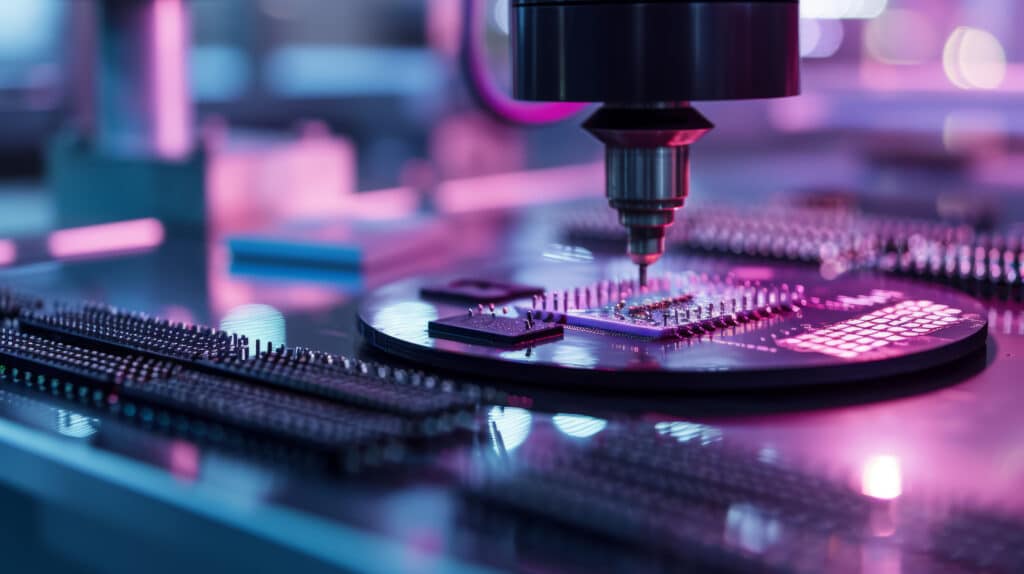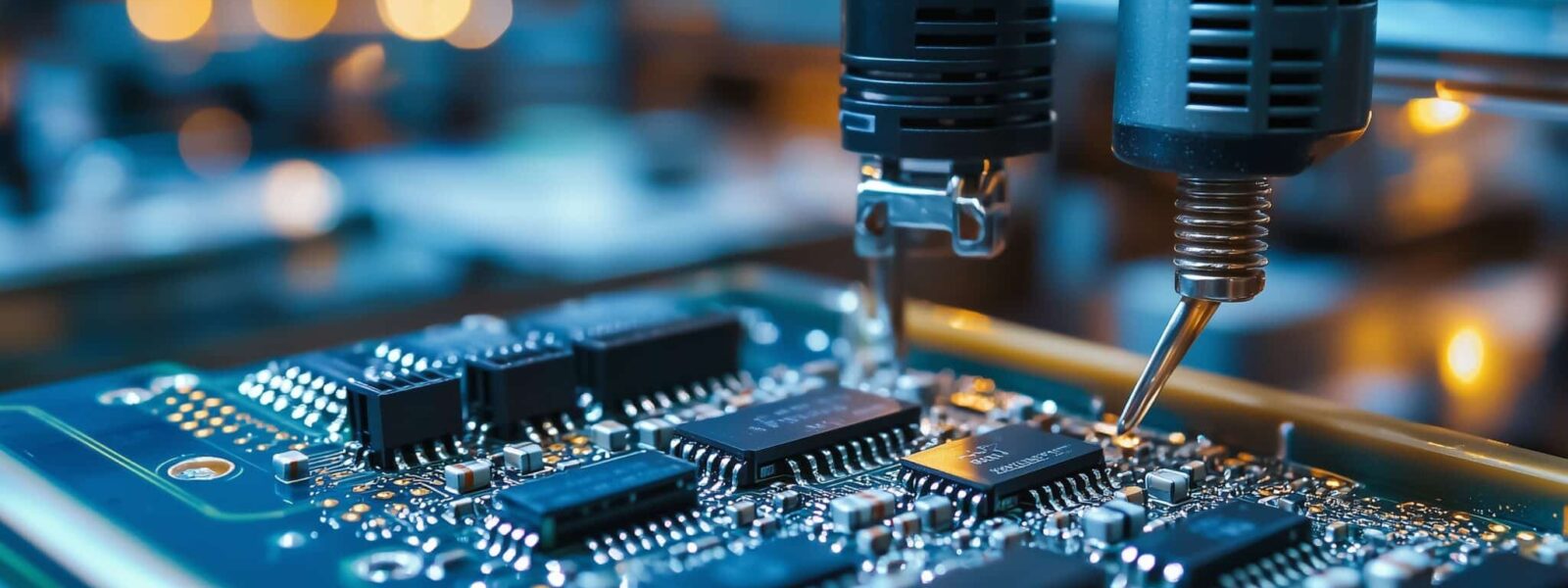Semiconductors: can European industry regain ground?
- To counter its dependence on Asia and the United States in the electronic semiconductor market, Europe has launched the Chips Act.
- Europe accounts for just under 10% of global semiconductor production, thanks to manufacturers such as the French company STMicroelectronics.
- To maintain its position, Europe must invest in its strengths: technological innovation, production, environmental issues, etc.
- Europe can capitalise on its strengths in edge AI, artificial intelligence managed on devices such as smartphones, connected objects, etc.
- The FAMES project, led by the European Commission and France, currently represents an investment of €830m in the sector.
The global market for electronic components will be worth $625bn in 2024. During the Covid-19 pandemic and the resulting shortage of chips, Europe was reminded of its dependence on Asia and the United States. In an attempt to limit this dependence, the European Union announced the launch of the CHIPS and Science Act in February 2022, which aimed to stimulate European production. Some three years later, how is the sector faring in Europe? We take stock with Sébastien Dauvé, director of CEA-Leti, who has just launched the FAMES pilot line in Grenoble, funded by the European Union and France.
How is the microelectronics market performing today?
Sébastien Dauvé. After a decline in 2023, the market has been growing since 2024, but this growth masks a two-speed evolution. The mature semiconductor sector, such as microcontrollers, which were in short supply for industry and the automotive sector in 2022–2023, is now saturated. At the same time, we are seeing an explosion in the market for very advanced node components (less than 5 nm), stimulated by very strong demand for chips for data centres and artificial intelligence applications: graphics processing units (GPUs) and high bandwidth memory (HBM). The investments in these fields are staggering: Taiwanese company TSMC, for example, has announced that it will invest $100bn in the United States over the next four years.
During the shortage, we realised once again that the electronic components market was both highly globalised and highly polarised, with the main players located in Asia and the United States. Has this structure changed?
The investments required to deploy new industrial resources are such that we cannot imagine a major change in the short term. It is therefore still characterised today by a very strong interdependence on a global level: a component can be designed on one continent and produced on a second, while the raw materials are supplied by a third. The United States, for example, excels in the design of integrated circuits. Japan has taken the lead in the production of wafers (the semiconductor wafers on which electronic components are printed) and process gases, and China is unavoidable for the supply of rare earths. Taiwan and South Korea, through the TSMC and Samsung foundries, dominate chip production – TSMC is even the only one to master the most advanced nodes (2 nm), which are highly innovative and in great demand today.
What is Europe’s place in this environment?
Europe accounts for just under 10% of global semiconductor production, thanks to manufacturers such as the French company STMicroelectronics, which ranks around 10th in the world. Although it does not have the capacity to produce advanced nodes, it is rather well positioned in the design and production of ‘More than Moore’ components, consisting of sensors, imagers, power and telecom components, and microcontrollers. This class finds applications in various sectors of activity, such as automotive, industry, defence and health. The continent also has near-monopolies in specific fields: the Dutch company ASML, for example, is the only player to have mastered the manufacture of EUV advanced lithography equipment, which is essential for foundries.

Finally, Europe benefits from active research and significant innovation capabilities, particularly through its RTOs (Research and Technology Organisations, including CEA-Leti, the Belgian IMEC, the German Fraunhofer, the Finnish VTT, etc.), a unique organisational model capable of driving innovation from the earliest stages of research through to pre-industrialisation.
The Chips Act aimed to double the share of the European contribution to world production by 2030, bringing it to 20%. In the current context, does this seem realistic to you?
We knew that this objective was very ambitious… I would say that in the short and medium term, it is more a question of maintaining our position in the current market and retaining our sovereignty over the most strategic developments when we have the means to do so: in particular, those relating to defence and cybersecurity, but also quantum computing, in which Europe is making good progress.
The European strategy also aimed to attract Intel factories in Germany and Poland, but the American giant suspended the project last September, while continuing its industrial expansion in the United States.
This is bad news for Europe, because it would be in our interest to have more players established here. In microelectronics, the notion of ecosystem is very important. In Grenoble, we are fortunate to have an ecosystem that has reached critical mass, bringing together the entire value chain, from start-ups to large groups, and this is invaluable.
How can we maintain our position in an increasing economically aggressive international context, which is tending towards national protectionism?
We must continue to invest in our strengths, from technological innovation to production, but also strengthen the links between the semiconductor and the areas of application that are of vital importance for Europe (industry, automotive, health, etc.), which have now become fully aware of the importance of components.
Europe is also ahead of the game when it comes to taking environmental and energy issues into consideration: these two constraints represent significant opportunities for innovation. The CEA is, for example, leading the European GENESIS project, bringing together 50 partners, with the aim of accelerating eco-innovation in semiconductor manufacturing processes. We also aim to reduce component consumption by a factor of 1000 by 2032.
Above all, however, we must not forget that the microelectronics market is cyclical by nature: what is true today will not necessarily be true tomorrow.
What developments do you foresee?
A major trend is emerging in which Europe could play to its strengths: edge AI, artificial intelligence managed not in data centres but on peripherals, smartphones, connected objects, industrial units, etc. These embedded applications require electronics that are both very energy efficient and capable of performing the inference phase, or even the learning phase, locally. However, traditionally, the units dedicated to calculation and those dedicated to memory are separated on the chips: 80 to 90% of the energy is consumed in the transmission of data between the two. Edge AI will therefore require innovations in electronic architecture, in which Europe has a role to play. It will also be closely linked to sensors, which are a European strength.
CEA-Leti has been selected to run one of the three pilot lines provided for by the Chips Act, FAMES, located in Grenoble. What resources does it have?
FAMES allows us to build 2,000 m² of additional clean rooms and to acquire around a hundred new items of industrial equipment, representing an investment of 830 million euros, supported by both the European Commission and the French State. It entered into operational service at the beginning of the year. We have kept perfectly to the planned schedule, which was very tight. It is important to emphasise this: when you know Asia, you know that operational execution is formidable there. This proves that we are capable of doing just as well.
What are FAMES’s objectives?
Its primary purpose will be to prepare FD-SOI technologies for 10 or even 7 nm nodes. This technology is currently produced by GlobalFoundries and STMicroelectronics, in 22 and 18 nm respectively. The target market remains modest on a global scale, but it is a particularly interesting solution for embedded applications that are looking for frugality. But FAMES should also enable us to prepare the ‘next step’ for European manufacturers, by accelerating the development of other technologies deemed key for the next 5–10 years: non-volatile embedded memories, which will play an essential role in the aforementioned nomadic AI uses, radiofrequency components, which will support the transition to 6G applications, and heterogeneous 3D integration, which will exploit stacking to integrate new functionalities on a single chip. It should be added that we will participate in the other pilot lines provided for by the Chips Act.
These pilot lines aim to prepare for Europe’s industrial future in the field of semiconductors in the short, medium and long term. There is sometimes talk of difficulties in collaborating at the European level: this is far from being the case in the field of microelectronics. We work in close collaboration, making the most of our complementary skills, in order to respond effectively to the strategic urgency we face.















